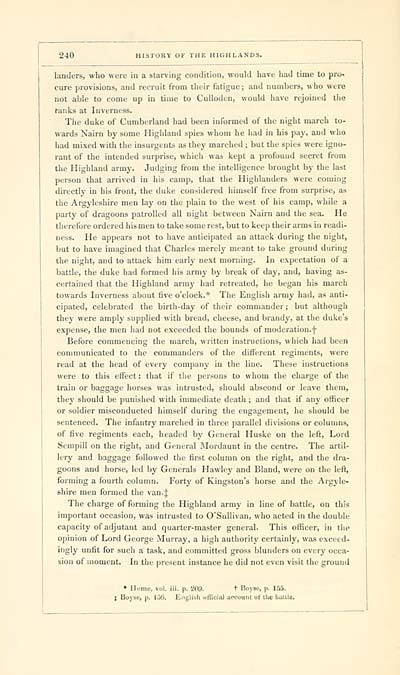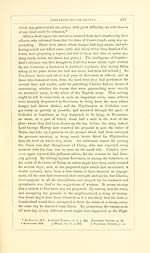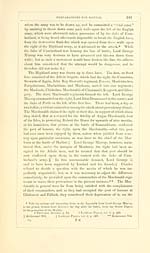Download files
Complete book:
Individual page:
Thumbnail gallery: Grid view | List view

240 HISTORY OF THE HIGHLANDS.
landers, who were in a starving condition, would have had time to pro-
cure provisions, and recruit from their fatigue; and numbers, who were
not able to come up in time to CuUoden, would have rejoined the
tanks at Inverness.
The duke of Cumberland had been informed of the night march to-
wards Nairn by some Higldand spies whom he had in his pay, and who
had mixed with the insurgents as they marched ; but the spies were igno-
rant of the intended surprise, which was kept a profound secret from
the Higldand army. Judging from the intelligence brought by the last
person that arrived in his camp, that the Highlanders were coming
directly in his front, the duke considered himself free from surprise, as
the Argyleshire men lay on the plain to the west of his camp, while a
party of dragoons patrolled all night between Nairn and the sea. He
therefore ordered his men to take some rest, but to keep their arras in readi-
ness. He appears not to have anticipated an attack during the night,
but to have imagined that Charles merely meant to take ground during
the night, and to attack him early next morning. In expectation of a
battle, the duke had formed his army by break of day, and, having as-
certained that the Highland army had retreated, he began his march
towards Inverness about five o'clock.* The English army had, as anti-
cipated, celebrated the birth-day of their commander ; but although
they were amply supplied with bread, cheese, and brandy, at the duke's
expense, the men had not exceeded the bounds of moderation.f
Before commencing the march, written instructions, which had been
communicated to the commanders of the different regiments, were
read at the head of every company in the line. These instructions
were to this eftect : that if tiie persons to whom the charge of the
train or baggage horses was intrusted, should abscond or leave them,
they should be punished with immediate death ; and that if any officer
or soldier misconducted himself during the engagement, he should be
sentenced. The infantry marched in three parallel divisions or colunms,
of five regiments each, headed by General Huske on the left. Lord
Sempill on the right, and General Mordaunt in the centre. The artil-
lery and baggage followed the first column on the right, and the dra-
goons and horse, led by Generals Hawley and Bland, were on the left,
forming a fourth column. Forty of Kingston's horse and the Argyle-
shire men formed the van. J
The charge of forming the Highland army in line of battle, on this
important occasion, was intrusted to O'SuUivan, who acted in the double
capacity of adjutant and quarter-master general. This officer, in the
opinion of Lord George Murray, a high authority certainly, was exceed-
ingly unfit for such a task, and committed gross blunders on every occa-
sion of moment. In the present instance he did not even visit the ground
• Hume, vol. iii. p. 203. t Boyae, p. 155.
] Boyse, p. 156. EiigJish otiiciaj aecuunt ot the bailie.
landers, who were in a starving condition, would have had time to pro-
cure provisions, and recruit from their fatigue; and numbers, who were
not able to come up in time to CuUoden, would have rejoined the
tanks at Inverness.
The duke of Cumberland had been informed of the night march to-
wards Nairn by some Higldand spies whom he had in his pay, and who
had mixed with the insurgents as they marched ; but the spies were igno-
rant of the intended surprise, which was kept a profound secret from
the Higldand army. Judging from the intelligence brought by the last
person that arrived in his camp, that the Highlanders were coming
directly in his front, the duke considered himself free from surprise, as
the Argyleshire men lay on the plain to the west of his camp, while a
party of dragoons patrolled all night between Nairn and the sea. He
therefore ordered his men to take some rest, but to keep their arras in readi-
ness. He appears not to have anticipated an attack during the night,
but to have imagined that Charles merely meant to take ground during
the night, and to attack him early next morning. In expectation of a
battle, the duke had formed his army by break of day, and, having as-
certained that the Highland army had retreated, he began his march
towards Inverness about five o'clock.* The English army had, as anti-
cipated, celebrated the birth-day of their commander ; but although
they were amply supplied with bread, cheese, and brandy, at the duke's
expense, the men had not exceeded the bounds of moderation.f
Before commencing the march, written instructions, which had been
communicated to the commanders of the different regiments, were
read at the head of every company in the line. These instructions
were to this eftect : that if tiie persons to whom the charge of the
train or baggage horses was intrusted, should abscond or leave them,
they should be punished with immediate death ; and that if any officer
or soldier misconducted himself during the engagement, he should be
sentenced. The infantry marched in three parallel divisions or colunms,
of five regiments each, headed by General Huske on the left. Lord
Sempill on the right, and General Mordaunt in the centre. The artil-
lery and baggage followed the first column on the right, and the dra-
goons and horse, led by Generals Hawley and Bland, were on the left,
forming a fourth column. Forty of Kingston's horse and the Argyle-
shire men formed the van. J
The charge of forming the Highland army in line of battle, on this
important occasion, was intrusted to O'SuUivan, who acted in the double
capacity of adjutant and quarter-master general. This officer, in the
opinion of Lord George Murray, a high authority certainly, was exceed-
ingly unfit for such a task, and committed gross blunders on every occa-
sion of moment. In the present instance he did not even visit the ground
• Hume, vol. iii. p. 203. t Boyae, p. 155.
] Boyse, p. 156. EiigJish otiiciaj aecuunt ot the bailie.
Set display mode to: Large image | Transcription
Images and transcriptions on this page, including medium image downloads, may be used under the Creative Commons Attribution 4.0 International Licence unless otherwise stated. ![]()
| Early Gaelic Book Collections > Ossian Collection > History of the Highlands and of the Highland clans > Volume 3 > (274) |
|---|
| Permanent URL | https://digital.nls.uk/79655710 |
|---|
| Description | Vol. III. |
|---|---|
| Shelfmark | Oss.249 |
| Attribution and copyright: |
|
| Description | Selected books from the Ossian Collection of 327 volumes, originally assembled by J. Norman Methven of Perth. Different editions and translations of James MacPherson's epic poem 'Ossian', some with a map of the 'Kingdom of Connor'. Also secondary material relating to Ossianic poetry and the Ossian controversy. |
|---|
| Description | Selected items from five 'Special and Named Printed Collections'. Includes books in Gaelic and other Celtic languages, works about the Gaels, their languages, literature, culture and history. |
|---|

